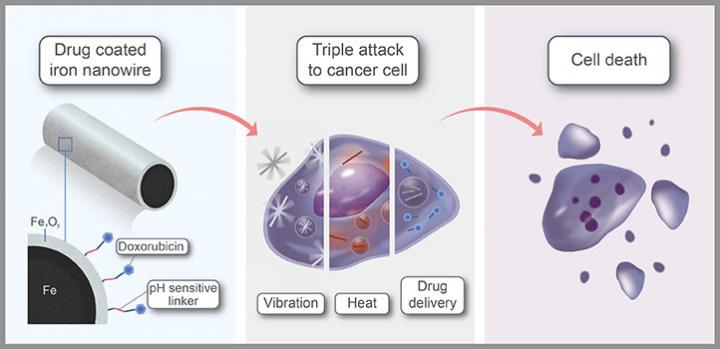Iron nanorobots show their true mettle

By combining low-power magnetic fields, which agitates nanowires, with laser heating and drug delivery, target cells can be killed efficiently. Credit: 2019 KAUST
Co-developed by KAUST researchers, these nanowires release their drug cargo inside cancer cells, while also punching holes in the cell's membrane and delivering a blast of heat. While the combination therapy maximizes cancer cell death, its highly targeted nature should minimize side effects.
Iron was the obvious material to make the nanowires, says Jürgen Kosel, who leads the group at KAUST, which includes Jasmeen Merzaban and Boon Ooi, and who co-led the work with researchers from CIC biomaGUNE in San Sebastian, Spain.
The first consideration is safety. “Iron, in molecular form, is a native material in our bodies, essential for oxygen transport,” Kosel explains. The nanowires comprise an iron core, coated with an iron oxide shell. “Iron-oxide-based nanomaterials have been approved by regulatory bodies for use in magnetic resonance imaging and as a dietary supplement in cases of nutrition deficiency,” he says.
In addition to their biocompatibility, the magnetic properties of iron-based materials are a key benefit. “Using harmless magnetic fields, we can transport them; concentrate them in the desired area; rotate or make them vibrate, such as we did in this study; and even detect them through magnetic resonance imaging,” says Aldo Martínez-Banderas, a member of Kosel's team. Applying low-power magnetic fields, the team agitated the nanowires in a way that opened the membrane of target cells, inducing cell death.
The additional advantage is that core-shell nanowires strongly absorb near-infrared light, heating up as they do so. Because light at this wavelength can penetrate far into the body, the nanowires could be heated using lasers directed at the tumor site. “The core-shell nanowires showed an extremely high photothermal conversion efficiency of more than 80 percent, which translated into a large intracellular heat dose,” Martínez-Banderas says.
Finally, the anticancer drug doxorubicin was attached to the nanowires via pH-sensitive linkers. As the tumor environment is typically more acidic than healthy tissue, the linker selectively degraded in or near tumor cells, releasing the drug where it is needed. “The combination of treatment resulted in nearly complete cancer cell ablation and was more effective than individual treatments or the anticancer drug alone,” Martínez-Banderas says.
“Taken together, the capabilities of iron-based nanomaterials make them very promising for the creation of biomedical nanorobots, which could revolutionize healthcare,” Kosel adds. “While this might seem futuristic, the developments are well on their way.”
References
- Martínez-Banderas, A. I., Aires, A., Quintanilla, M., Holguín-Lerma, J. A., Lozano-Pedraza, C., Teran, F.J., Moreno, J.A., Perez, J.E., Ooi, B.S., Ravasi, T., Merzaban, J.S., Cortajarena, A.L. & Kosel, J. Iron-based core−shell nanowires for combinatorial drug delivery and photothermal and magnetic therapy. ACS Applied Materials & Interfaces 11, 43976-43988 (2019).| article
Media Contact
All latest news from the category: Life Sciences and Chemistry
Articles and reports from the Life Sciences and chemistry area deal with applied and basic research into modern biology, chemistry and human medicine.
Valuable information can be found on a range of life sciences fields including bacteriology, biochemistry, bionics, bioinformatics, biophysics, biotechnology, genetics, geobotany, human biology, marine biology, microbiology, molecular biology, cellular biology, zoology, bioinorganic chemistry, microchemistry and environmental chemistry.
Newest articles

Properties of new materials for microchips
… can now be measured well. Reseachers of Delft University of Technology demonstrated measuring performance properties of ultrathin silicon membranes. Making ever smaller and more powerful chips requires new ultrathin…

Floating solar’s potential
… to support sustainable development by addressing climate, water, and energy goals holistically. A new study published this week in Nature Energy raises the potential for floating solar photovoltaics (FPV)…

Skyrmions move at record speeds
… a step towards the computing of the future. An international research team led by scientists from the CNRS1 has discovered that the magnetic nanobubbles2 known as skyrmions can be…





















